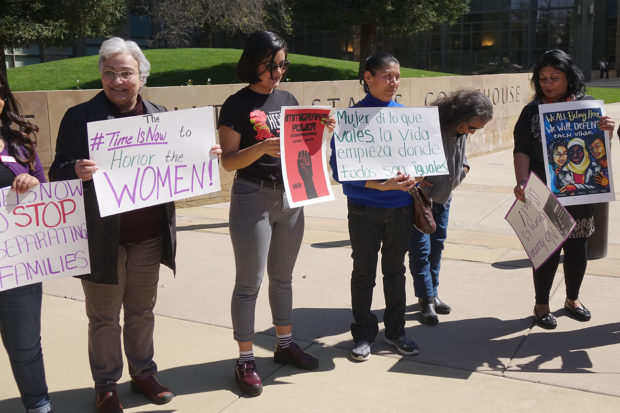
By Myrna Martinez Nateras
Without a doubt, 2020 was an unprecedented year, not only because of the first pandemic of the 21st century but also because of the U.S. election in which the popular vote defeated White supremacism. However, the most impressive outcome of that election was Kamala Harris becoming vice president.
For the first time, the most powerful country in the world has chosen a female vice president, who also becomes the first Black person and first daughter of immigrants to be vice president. This is a triumph for the feminist movement and for all women. The election of Harris as vice president is also an achievement for Shyamala Gopalan Harris, Kamala’s mother, who like millions of women left her country seeking a better life.
This political victory deserves to be recognized on March 8—International Women’s Day. Moreover, the day provides a good opportunity to raise the voices of immigrant and refugee women for whom poverty, war and gender violence forced them to leave their countries and communities. It is also an opportunity to highlight the presence and social and cultural contributions of immigrant and refugee women.
Harris now has a platform through which to advocate on behalf of immigrant women. Some immigrant women have resided in the United States for more than 20 years, being productive, while building families and a sense of belonging, yet remain invisible to those responsible for making decisions on immigration policy.

On March 8, the Biden-Harris administration should recognize the Dreamers’ mothers who, similar to Harris’s mother, yearn for a better quality of life for their daughters and families. The time is now to stop immigration policies that have created different layers of immigration status within families.
The invisibility and lack of recognition of immigrant economic, social and cultural contributions is one of the many problems immigrants face and particularly immigrant women. In part, this is because most social studies about immigration focus on men, who were the main labor force of the Bracero program (1942–1964). When that program ended, the demand for cheap labor didn’t stop. So new waves of immigrants continued coming in—but without work permits.
The American Friends Service Committee (AFSC) launched the Pan Valley Institute (PVI) 12 years after the Immigration Reform and Control Act (IRCA) of 1986 was enacted. One of the central intentions of this program was strengthening the leadership capacity and fostering the civic engagement of immigrants, mostly Latinos, who became residents under the IRCA.
By the time the PVI got under way, the demographic composition of Mexican immigrants had changed. In the early 1990s, we saw a new wave of immigrants coming to the United States mostly of indigenous origin. Young indigenous women came to work on the Central Valley fields to send money to their families back in the Mexican states of Oaxaca or Guerrero.
Other women came to join their families already working in the United States, bringing with them their children, now known as Dreamers. Those women should be recognized as the true first Dreamers because they traveled a long and arduous road from their homes, displaced by international neoliberal policies that ruined their habitats to benefit corporations and local landlords. These immigrant women came with the dream of a dignified life.
Some of these women were the first to participate in the popular education projects facilitated by the PVI. Indigenous women from Mexico and refugee women from Southeast Asia got together periodically for several years, strengthening their organizing abilities, sharing their stories and goals, and working to lift their voices and give visibility to immigrant and refugee women.
After 20 years, and now with their own families, these women continue advocating for the social, economic and cultural well-being of their communities. Many are now leaders, others started businesses and all continue to resist gender, racial, class and immigration status discrimination.
There is a public opinion perception that immigrant and refugee women become liberated in the United States by learning from American women and their family structure. This stereotyped view is an expression of unawareness of the skills and resilience of these women, and of the talents, skills and cultural indigenous knowledge they bring with them.
It is an indication of the limited knowledge of the women’s movements in Mexico and Latin America, which have been continually strengthening since the 1970s. In Mexico, the women’s movement to achieve political rights can be traced back to the Mexican Revolution (1910–1919), as registered in a chronology published by the Department of Elections of Sinaloa, Mexico.
For more than 20 years, immigrant and refugee women in the Central Valley have celebrated International Women’s Day, sharing their demands with millions of women around the world, seeking gender and social equality, the end of domestic violence, the defense of their cultural rights, pushback against the damages of neoliberalism and more.
Immigrant and refugee women are establishing their own agendas and planting the seeds of an immigrant and refugee women’s movement to defend cultural diversity, stop discrimination and promote just immigration policies. They oppose immigration via the rule of the free market—as part of the capitalistic system—that denies fair salaries, dignified labor and living conditions, and the right to exercise their political rights.
We urge those who will sit at the negotiating table of the Biden-Harris administration immigration policies to celebrate all immigrant women on March 8 and seek a serious and deep solution to the immigration status of the Dreamers’ mothers.
*****
Myrna Martinez Nateras is the director of the Pan Valley Institute in Fresno, which is part of the American Friends Service Committee.
